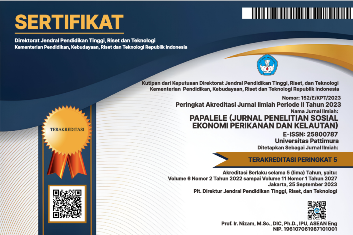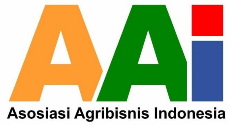EFISIENSI DAN KEBERLANJUTAN USAHA PURSE SEINE DI KABUPATEN MALUKU TENGAH DAN KOTA AMBON
Abstract
The level of purse seine business income is determined by the efficient allocation of resources for alternative capture fisheries activities. If resources are not used efficiently, there will be unexploited potential to increase income and create surpluses. Conversely, if resources are allocated efficiently, additional capture fisheries can be obtained through growth-oriented development efforts. Therefore, it is important to identify the efficient use of resources to determine the existence of purse seine fisheries. The results show that the estimated technical efficiency of the catch with SPF (Stochastic Production Frontier) analysis for purse seine fisheries in Central Maluku Regency and Ambon was influenced by the length and width of fishing gear, number of fishermen, amount of investment value and time of capture operations. The minimum value of catch technical efficiency is 0.10 and the maximum is 0.99 with an average 0.48. Factors influencing the technical inefficiency of fishing are the experience of captain and the education level of fishermen. Purse seine fishery business in Central Maluku Regency and Ambon City is feasible to be developed, showing by NPV value Rp. 30,514,684 / year, IRR 23.97% and B / C ratio 5.85. The average return on investment (PP) based on the analysis is 2.16 years, with BEP price Rp. 6,606 and BEP production 3,765 kgs. The main priorities of purse seine fisheries development policy strategy in Central Maluku Regency and Ambon are the development of assistance to fishing groups, the development of appropriate technology to handle catches, increase fisheries production, and infrastructures development.
Downloads
References
[BRKP] Badan Riset Kelautan Perikanan dan LIPI, Jakarta. 2001. Pengkajian Stok Ikan di Perairan Indonesia. Kerjasama PRPT-BRKP-DKP dan PPPO-LIPI. Jakarta. 125 hal.
[DKP RI] Dinas Kelautan dan Perikanan Republik Indonesia. 2006. Statistik Kelautan dan Perikanan Tahun 2005. Departemen Kelautan dan Perikanan, Republik Indonesia.
[DKP Maluku] Dinas Kelautan dan Perikanan Maluku. 2007. Laporan Tahunan 2005. Dinas Perikanan dan Kelautan Provinsi Maluku. Ambon.
Effendi I dan Oktariza W. 2006. Manajemen Agribisnis Perikanan. Penerbit: Penebar Swadaya. Jakarta.
Hiariey, J. 2009. Pengelolaan Antar Waktu Perikanan Pelagis Kecil di Provinsi Maluku Berdasarkan Kapsitas Penangkapan Ikan (Ringkasan Disertasi). Institut Pertanian Bogor. Bogor.
Hiariey. J dan St. M. Siahainenia. 1997. Kondisi Sosial Ekonomi Nelayan Bagan di Kabupaten Maluku Tengah. Laporan Penelitian Kerjasama Dengan Agricultural Research Management Project II (ARMP II).
Kirkley, J. E et al,. 2004. Deterministic and Stochastic Capacity Estimation For Fishery Capacity Reduction. Ichthyos, Vol. 8 No. 2, Juli 2009:
Lipsey dan Steiner. 1985. Pengantar Ilmu Ekonomi. Edisi Keenam. Penerbit PT. Bima Aksara. Jakarta.
Nicholson. W. 1991. Teori Ekonomi Mikro. Edisi Revisi. Penerbit Rajawali Press. Jakarta.
Nurkahim. S; V. P. H. Nikijuluw; D. Nugroho; B. I. Prisanto. 2007. Statuts Perikanan Menurut Wilayah Pengelolaan. Informasi Dasar Pemanfaatan Berkelanjutan. Pusat Riset Perikanan Tangkap, BRKP, Departemen Kelautan dan Perikanan.
Rangkuti. F. 2008. Analisis SWOT Teknik Membeda Kasus Bisnis Reorientasi Konsep Perencanaan Strategi Utama Menghadapi Abad – 21. PT. Gramedia Pustaka Utama. Jakarta.
Singgaribun. M dan Effendi. M. 2008. Metode Penelitian Survei (Ed Revisi). Lembaga Penelitian Pendidikan dan Penerangan Ekonomi dan Sosial (LP3ES). Jakarta.
Copyright (c) 2019 Margie Wattimury

This work is licensed under a Creative Commons Attribution-NonCommercial 4.0 International License.











